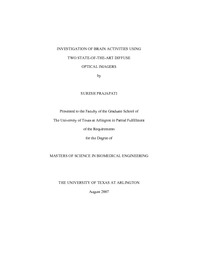
ATTENTION: The works hosted here are being migrated to a new repository that will consolidate resources, improve discoverability, and better show UTA's research impact on the global community. We will update authors as the migration progresses. Please see MavMatrix for more information.
Show simple item record
| dc.contributor.author | Prajapati, Suresh | en_US |
| dc.date.accessioned | 2007-09-17T17:07:34Z | |
| dc.date.available | 2007-09-17T17:07:34Z | |
| dc.date.issued | 2007-09-17T17:07:34Z | |
| dc.date.submitted | August 2007 | en_US |
| dc.identifier.other | DISS-1830 | en_US |
| dc.identifier.uri | http://hdl.handle.net/10106/618 | |
| dc.description.abstract | Near-Infrared Spectroscopy (NIRS) and diffuse optical imaging (DOI) are increasingly used to detect hemodynamic changes in the cerebral cortex induced by brain activity. The new commercially available DOI systems CW5 and DYNOT have large number of sources and detectors; by arranging them in specific patterns, one can cover most of the adult head. This study is a preliminary step in understanding CW5 and DYNOT and exploring their capabilities for various purposes. My work is divided in to three major parts. The first goal of this study was to study changes in hemodynamic response of brain during Breath holding, using both imagers. Three common subjects were studied on both imagers. The hemodynamic results show that total hemoglobin concentration increased during breath holding, which indicates increase in blood flow to that region. Second goal was to check the capabilities of these imagers in mapping brain activity during finger tapping. Data from five subjects was collected out of which for were common on both imagers. Results demonstrated that relative oxy hemoglobin concentration increased during activity period while exactly opposite behavior was seen for deoxy hemoglobin. Third goal for this work was to compare and contrast the results obtained from these imagers. For meaningful comparison, correlation coefficient (R) was calculated between various data sets. R values between these imagers for same subject were fairly high which indicate that the temporal responses of these match pretty well and both are capable of measuring the physiological responses with almost same accuracy. Along with providing potentials of these imagers, this work also helps in understanding the issues related to them so that they can be addressed in future to make studies more meaningful. | en_US |
| dc.description.sponsorship | Liu, Hanli | en_US |
| dc.language.iso | EN | en_US |
| dc.publisher | Biomedical Engineering | en_US |
| dc.title | Investigation Of Brain Activities Using Two State-of-the-art Diffuse Optical Imagers | en_US |
| dc.type | M.S. | en_US |
| dc.contributor.committeeChair | Liu, Hanli | en_US |
| dc.degree.department | Biomedical Engineering | en_US |
| dc.degree.discipline | Biomedical Engineering | en_US |
| dc.degree.grantor | University of Texas at Arlington | en_US |
| dc.degree.level | masters | en_US |
| dc.degree.name | M.S. | en_US |
| dc.identifier.externalLink | https://www.uta.edu/ra/real/editprofile.php?onlyview=1&pid=28 | |
| dc.identifier.externalLinkDescription | Link to Research Profiles | |
Files in this item
- Name:
- umi-uta-1830.pdf
- Size:
- 4.481Mb
- Format:
- PDF
This item appears in the following Collection(s)
Show simple item record


